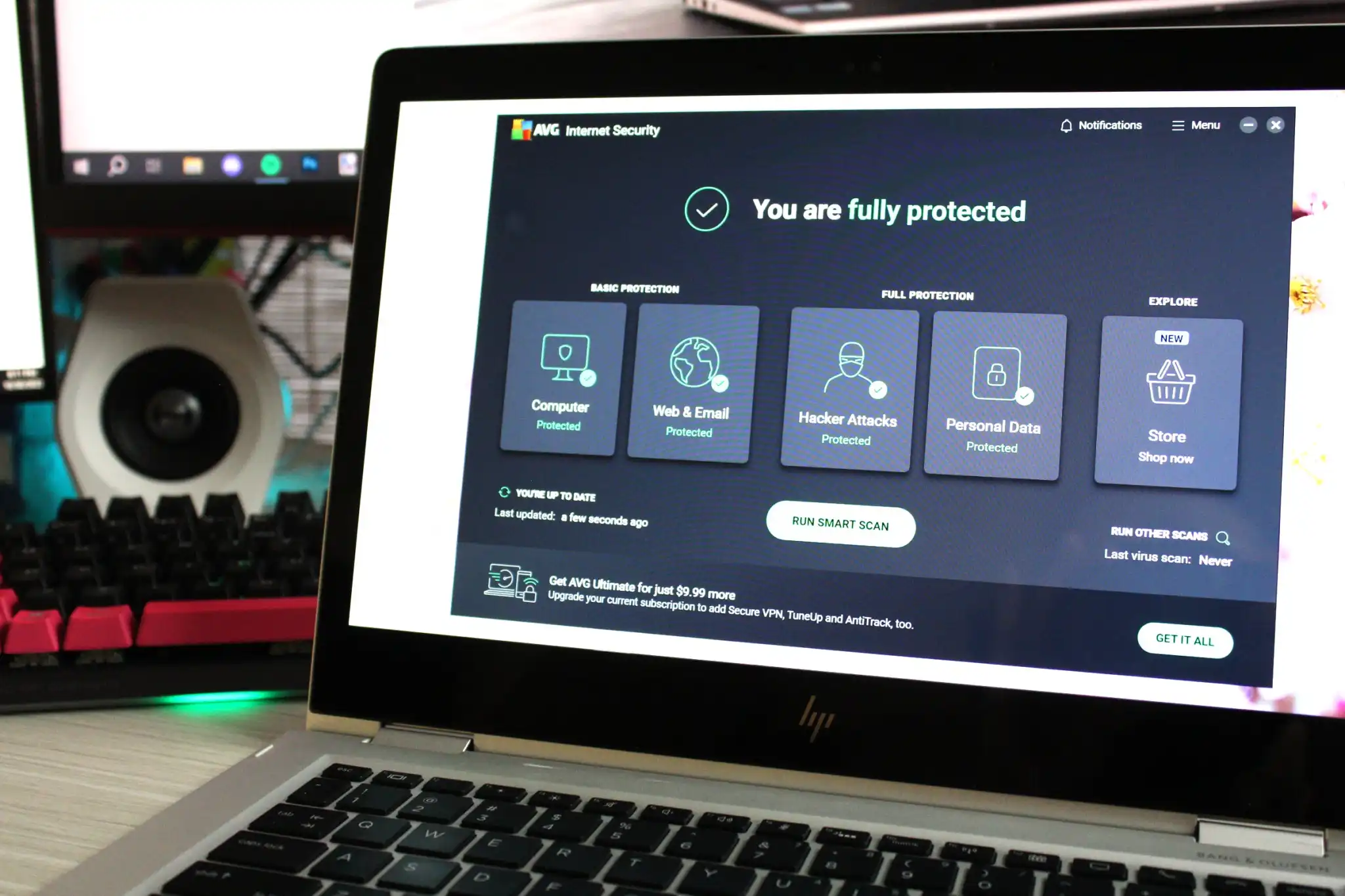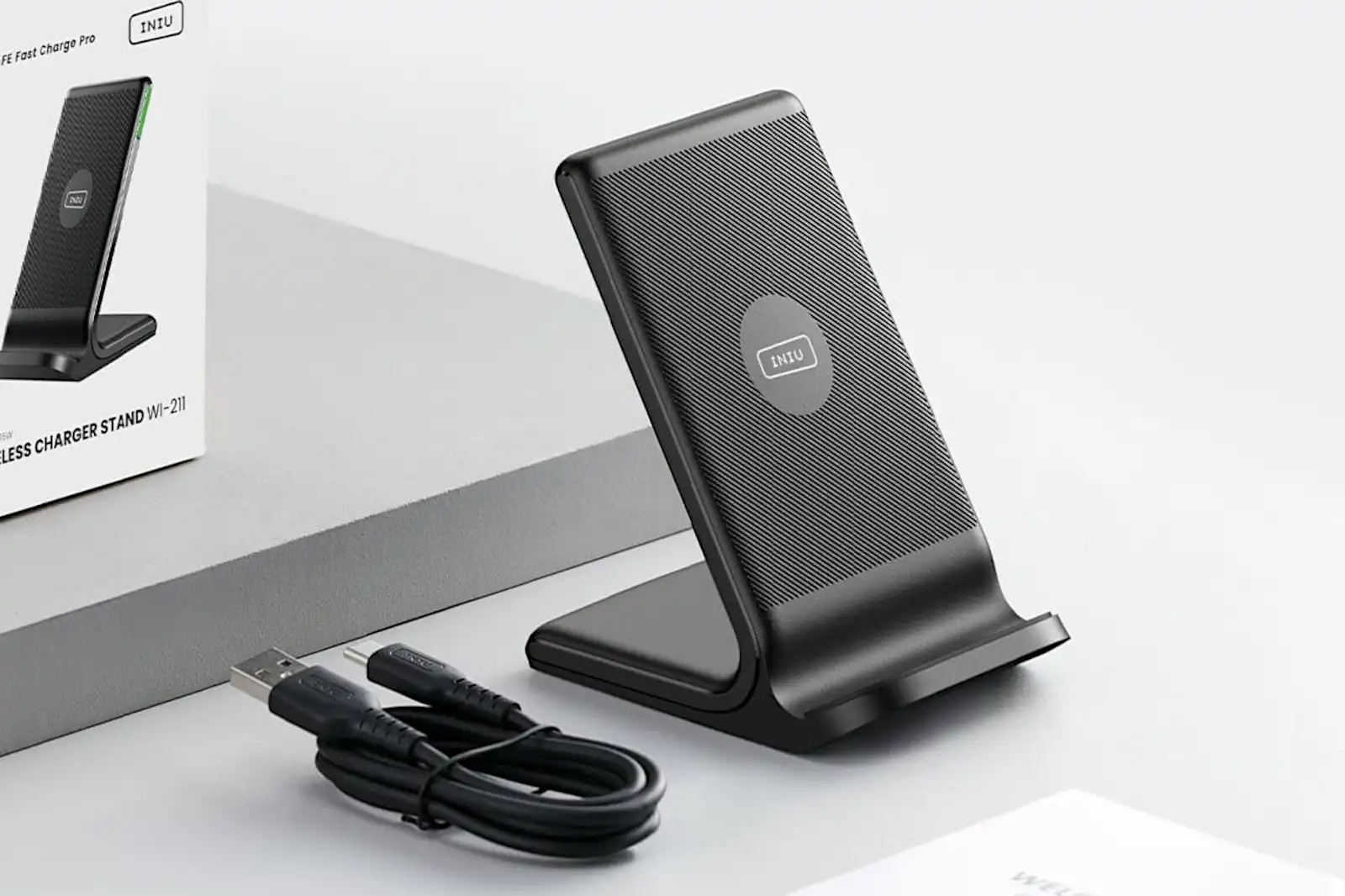AVG Internet Security rounds out the company’s solid antivirus software with additional online protections, while not costing too much.
AVG is best known for its excellent free antivirus software—so why pay a premium for the AVG Internet Security suite? In a word: convenience.
With security software, the more you pay, the more comprehensive your protection becomes. That can be valuable if you find keeping up with online threats too overwhelming or time consuming. There’s something to be said for a program that can handle the major elements for you. And that’s what AVG Internet Security, the company’s entry-level version of its paid antivirus software, provides.
By moving up to a paid subscription, you get additional features that keep you safer during your off days. No antivirus program is bulletproof, of course, but this one hits the major points while not overloading you with extras you won’t use. Whether it’s right for you depends on how much you prioritize simplicity.
How much does AVG Internet Security cost?
First, the basics—let’s talk about cost. If purchased directly from AVG, jumping from the free plan to the company’s Internet Security package is cheaper for the first year, and then reverts to the full price thereafter.
Single-device plan (1 PC)
- $47 for the first year
- $76 per year thereafter
10-device plan (Multiple devices)
- $60 for the first year
- $100 per year thereafter
AVG doesn’t offer family plans, but if you purchase a multi-device plan (which supports PC, Mac, Android, and iOS), you can share the device quota with family members. Even if you’re flying solo, the extra cash for multi-device coverage can be worth it—these days it’s common to own at least a computer and phone, and often a tablet as well.
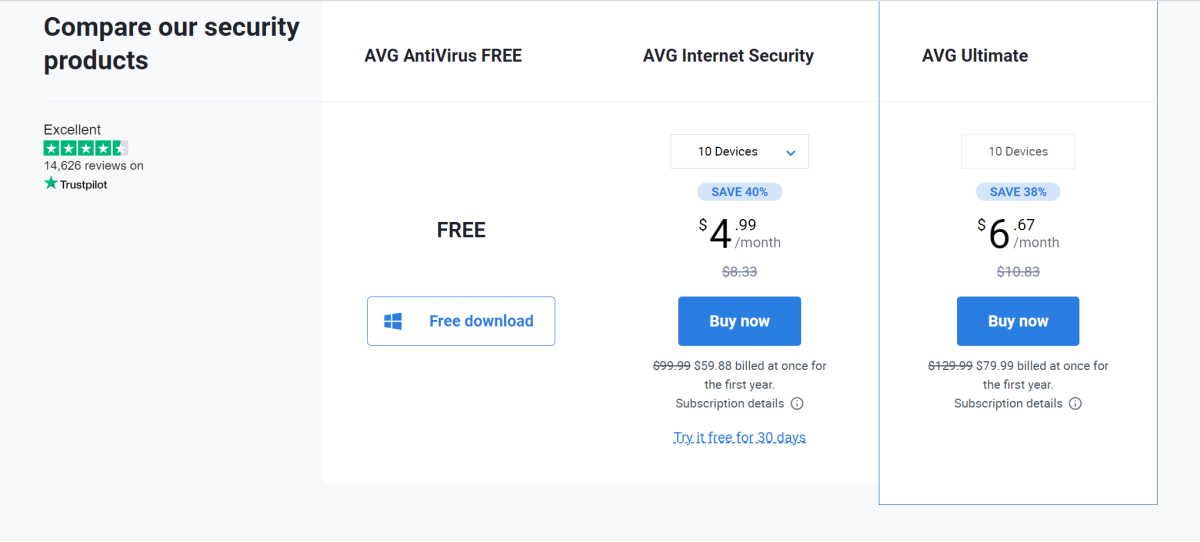
AVG
Compared to the competition, AVG prioritizes more devices rather than extra features. Take for example Norton—its closest equivalent plan includes VPN access, but you can only use it across five devices. Also surprising: Avast, which actually owns AVG, charges more for almost the exact same plan.
For more savings, you can buy a license for AVG Internet Security through retailers like Amazon or Newegg, which offer multi-year plans as well as ones with fewer devices—so you can get a subscription appropriately sized for your situation, if you prefer.
What does AVG Internet Security include?
AVG Internet Security adds five more features to the free plan’s antivirus, firewall, web and email threat, and network protection. You get safeguards for the passwords saved to your browsers; webcam takeovers; unknown access to files with sensitive data; malicious redirects for websites you’re trying to visit (aka DNS hijacking); and attacks conducted through Windows’ remote desktop protocol.
This particular plan does not include access to a VPN. AVG also doesn’t have its own password manager or parental controls, so you can’t get those by changing your subscription.
Key features of AVG Internet Security
Installation and user interface
To install AVG Internet Security, either download the free version and then upgrade, or first buy the paid subscription and install afterward.
AVG’s dashboard is clean and logical, though possibly gloomy for those who like light-themed apps. The nearly black background is punctuated with bright green text to cue you in to important information. Both your PC’s status and key features are clearly highlighted in the dashboard.
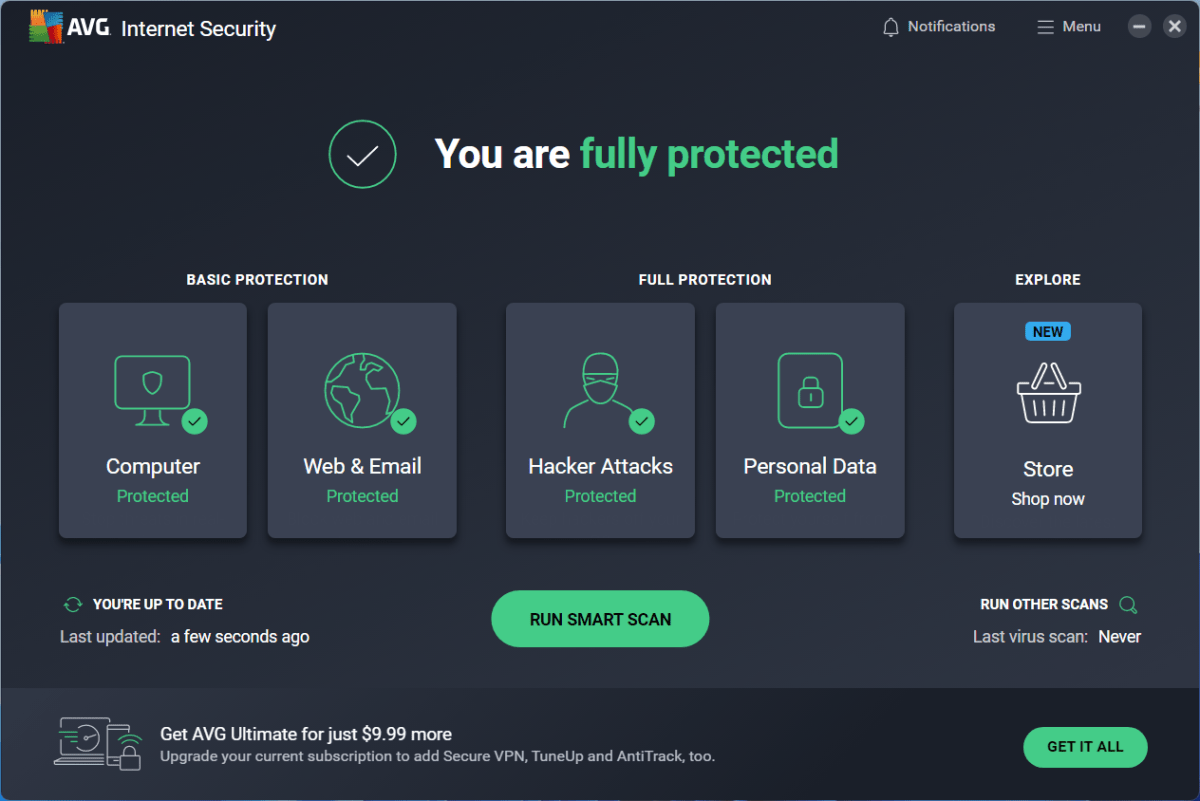
PCWorld
Starting a scan from the dashboard is easy—for a quick scan, you press the Run Smart Scan button toward the bottom of the screen. You can choose a different type of scan by clicking the text that says Run other scans. Your options are deep scan, file or folder scan, boot-time scan, USB/DVD scan, and a performance scan. Using the performance scan requires a separate subscription to AVG TuneUp, or a further upgrade to an AVG Ultimate plan.
Above the scan options are the dashboard tiles. Currently, there are four tiles related to the software’s features—the fifth is now reserved for the AVG store, through which you can purchase subscriptions for other AVG software not included with Internet Security.
If you click any of the main dashboard tiles—Computer, Web & Email, Hacker Attacks, and Personal Data—you’ll see explanations for each of the software’s components. You can also broadly customize your settings, either by toggling off a feature or fiddling with the defaults. For the best protection, most people should leave everything on and then further add items for protection where applicable.
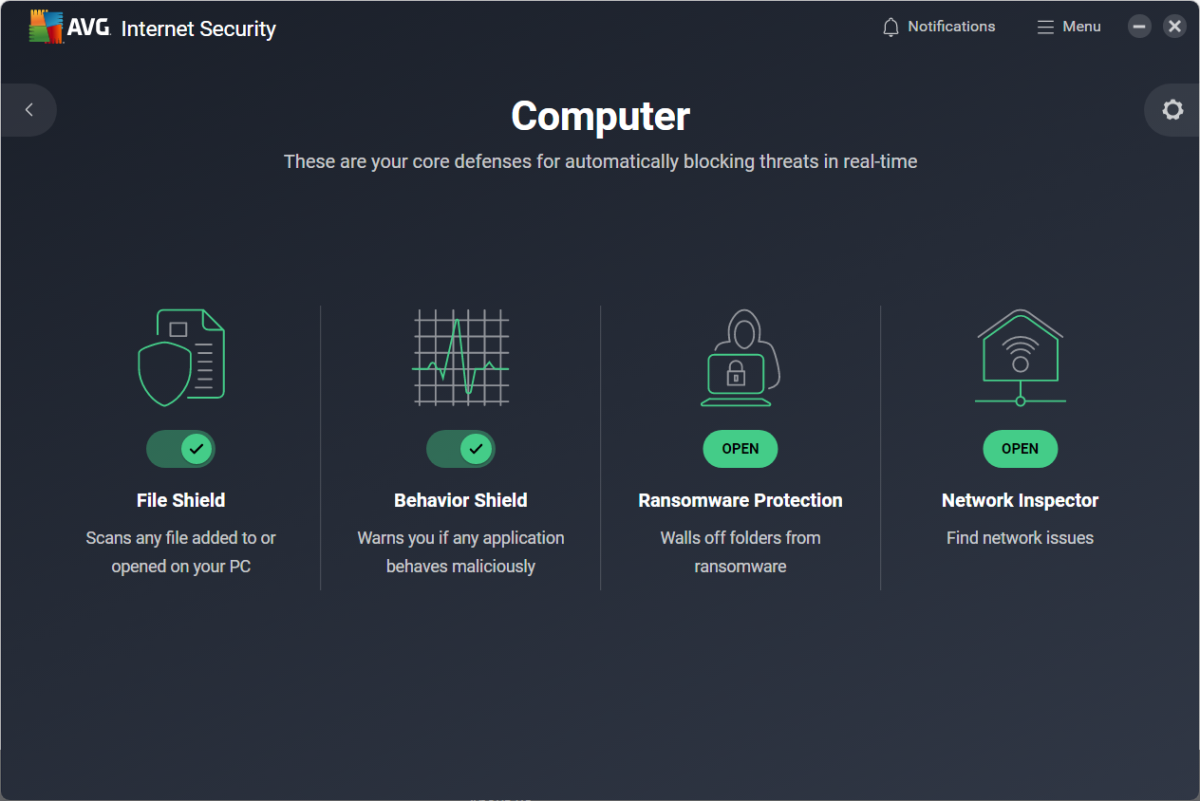
PCWorld
However, if you run into conflicts or annoyances that require a little fine-tuning, AVG does provide more granular control. To access, you’ll click on the Menu hamburger icon at the top right, then choose Settings. This dropdown menu gives access to features like the data shredder, subscription info, browser extensions, and support as well.
These detailed settings are a boon for software nerds, incidentally—particularly those of us who serve as tech support for loved ones. You can tweak a fair number of things, including privacy settings (you can opt out from data sharing right from the app), and even set a password to keep others from changing settings.
The only real issue with AVG’s app is the continued upsells for its other products. If you thought that paying for AVG would stop the flow, alas, no. It only reduces the amount.
Virus, malware, and threat protection
Real-time protection
AVG Internet Security protects your PC against real-time threats in multiple ways. On your PC, the software scans files you add or open, checks apps for unusual behavior, and controls access to select folders often targeted by ransomware. Ransomware protection is customizable, so you can add more folders to the default list. Email downloaded to your PC is screened for dangerous attachments and malicious links, too.
When you’re on the web, AVG Internet Security scans the data transmitted to your computer for malware and for any sneaky DNS redirections to fake websites. It also monitors traffic going to and from apps, and locks down the passwords saved to your browsers. You get protection from remote access attacks, too—AVG blocks remote connection attempts from unknown sources, and it restricts access to your webcam and microphone.
As a small protection against being caught unawares from data breaches, AVG Internet Security keeps tabs on your email address. If it’s spotted in a leak, you’ll get a notification in the app.
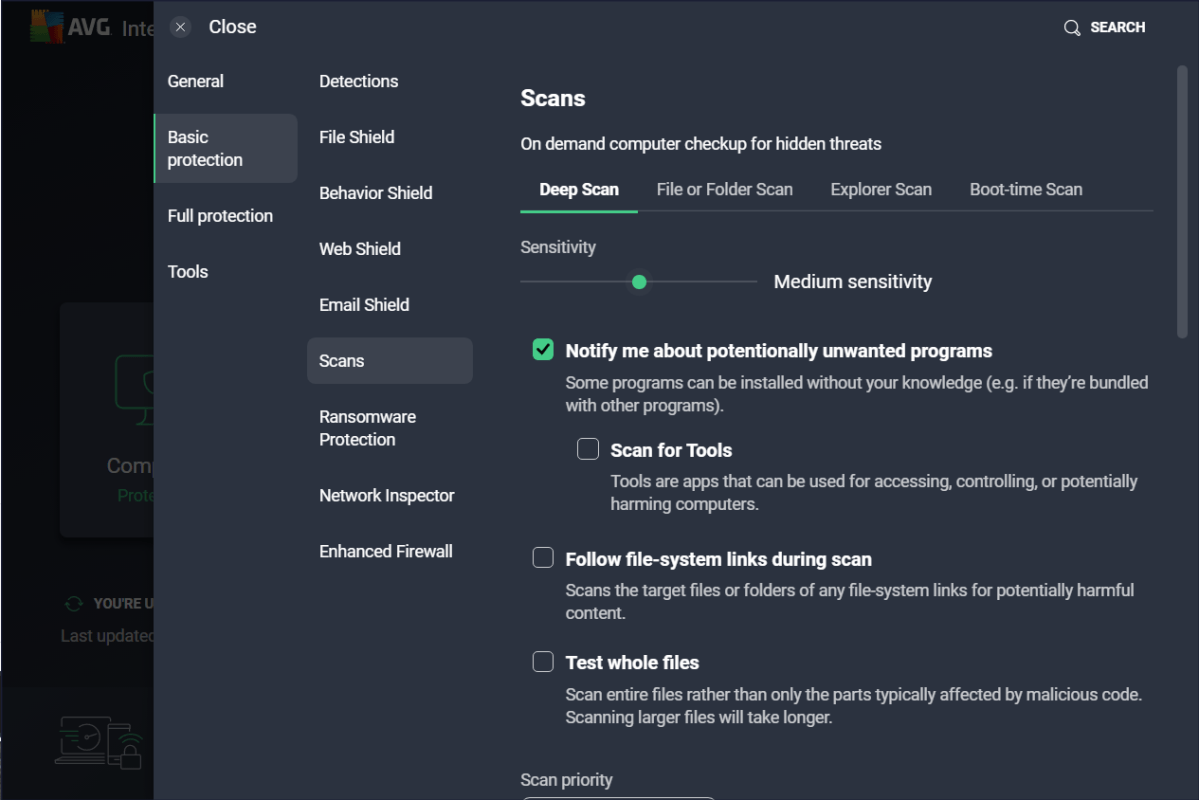
Scheduled and manual scans
By default, a smart scan (the equivalent of a quick scan in other antivirus software) is scheduled for once a month. You can adjust this timing and depth of scan, as well as add more scans to the list. You have four kinds to choose from: Deep Scan, File or Folder Scan, Boot-time Scan, and USB/DVD Scan.
Each type of scan is customizable in settings—for example, Deep Scan normally scans for files that are vulnerable to malware, and only for common installation apps. But you can make it dig further and have it scan all files, if you like. You can also change how the program handles infected files.
Additional features
Browser extensions
If you install AVG’s browser extension, you can add an extra layer of protection while visiting websites. It’ll flag unknown sites and also add status badges to Google and Bing search results. In my experience, I found it slightly overzealous at first—it threw up a warning when I navigated directly to www.google.com—but it seemed to calm down after that.
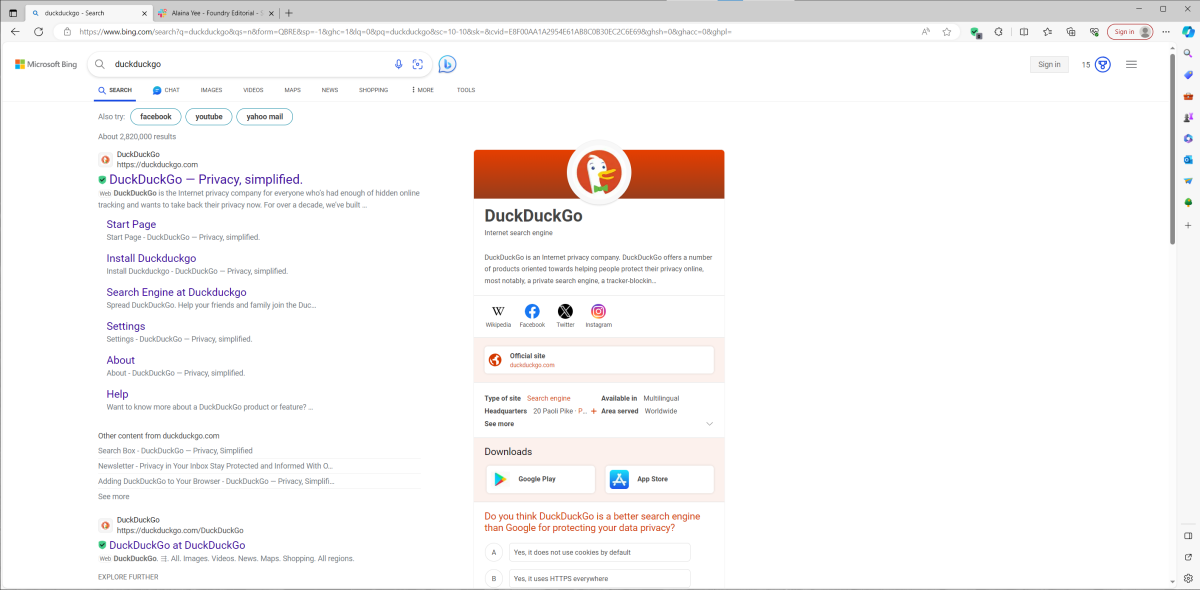
PCWorld
Data shredder
Formerly known as File Shredder, this feature lets you securely delete files, folders, or whole drives by overwriting them with other data. On the face of it, this sounds like a good feature—and it can be, if you want to clear data from a hard disk drive (HDD).
However, most modern computers have solid state drives (SSD), which save data in a different way than mechanical drives. At best, you won’t actually securely overwrite the data using this method, and at worst, you can shorten the life of your SSD. (You’ll want to use this method instead.)
Customer support
Aside from AVG’s support pages and forums, you can contact technical support through an online chat or through a phone call. The support pages are best for quick overviews and/or walkthroughs of various features, while the forums can help with troubleshooting—provided you’re willing to dig through several threads.
Updates and maintenance
Updates for both virus definitions and the app itself run automatically in the background, though you can change these to only remind you when an update is available or go full manual (which is not advised). If you want to manually trigger the update yourself, there’s also a button to check for updates. You can find this by heading to Settings > General > Update.
Performance
AVG generally gets extremely high marks for antivirus and malware protection from leading organizations that evaluate security software. In AV-Test’s zero-day attack and malware tests for March and April 2024 (the most current results released), AVG Internet Security detected 100 percent of the threats. When faced with 316 zero-day attack samples (including web and email threats) and 19,228 samples of recently widespread and prevalent malware, AVG blocked them all.
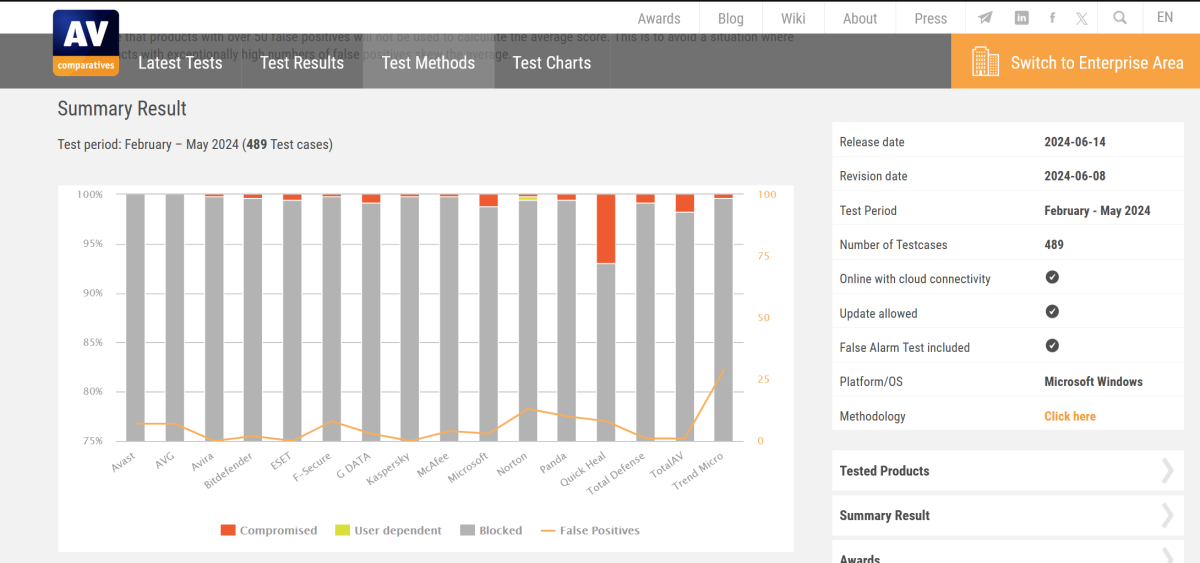
Similarly, in AV-Comparatives’ real-world protection test for February through May 2024, AVG’s antivirus engine caught 100 percent of the 489 test cases, with 5.5 false positives. That means if your PC encounters malicious web addresses, exploits (like drive-by downloads), or URLs that link directly to malware while on the web, AVG should do an excellent job of noticing and keeping you from harm. AVG also hit high marks in AV-Comparatives’ March 2024 malware protection test, scoring a 95.6 percent offline detection rate, 98.8 percent online detection rate, and 99.95 percent online protection rate, with ten false positives.
AVG falters a little when dealing with more sophisticated, targeted threats, like malicious scripts and fileless attacks. It caught 11 of the 15 test cases in AV-Comparatives’ November 2023 Advanced Threat Protection Test. However, antivirus software seems to be still ramping up on this front overall—AVG detected samples missed by higher performing rivals missed.
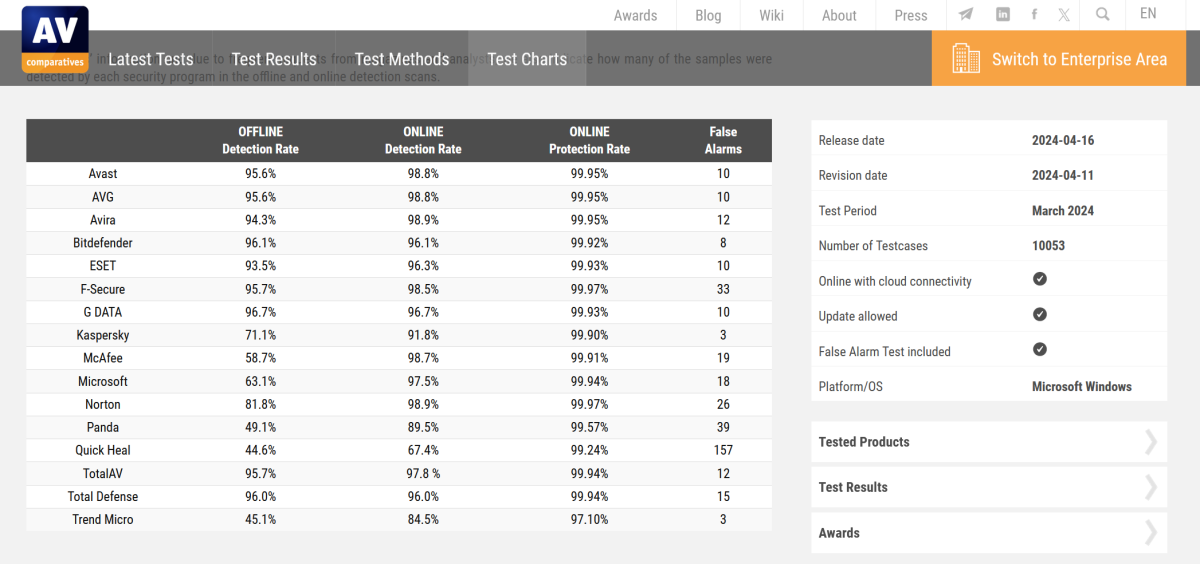
During my hardware performance tests on a modest Acer Aspire 3 laptop with an AMD Ryzen 5 7520U processor, a 128GB SSD, 8GB of RAM, and Windows 11 Home, AVG had no tangible impact on most typical tasks performed on a PC, as simulated by PCMark 10—e.g., video chatting, web browsing, gaming, image and document editing in free apps like GIMP and LibreOffice. Surprisingly, it also had little effect on our Handbrake encoding test, too.
However, running the same deep scan while using Microsoft Office (as simulated by UL Procyon) did cause a dip in performance on our budget laptop—an almost 20 percent drop. That means if you’re on a cheaper PC and slinging larger data sets in Excel, you’re best served scheduling your system scans for off-hours. The hit was a more palatable 9 percent decrease when AVG was left to idle in the background, keeping real-time watch for threats.
As for features, Sensitive Data Shield (which lets you scan your system for files containing high-risk pieces of personal information) was a bit hit or miss. For example, one invoice was flagged, but not another similar document that lacked the word “invoice.”
Other protections aren’t actually accessible with the Internet Security plan—though the interface is designed to make you think it is until the very last moment. E.g.: Running a Performance Scan will display action items. But if you click on the button to resolve them all, you get a screen asking you to pay for AVG TuneUp, as shown above.
The fact that the advertisements don’t completely cease once you start paying for AVG is a bit off-putting—it makes the app feel incomplete, even though you’ve got a full package.
Conclusion
AVG Internet Security is a fantastic option for people seeking to be more hands-off with online security without paying a ton for the convenience. In fact, it’s solid enough to still earn a recommendation despite how strong the free version is on its own. (And the continued upsells, because really, they’re incredibly annoying to see in a paid product.) It offers great performance and an easy-to-understand interface along with several helpful security features.
Editor’s note: Because online services are often iterative, gaining new features and performance improvements over time, this review is subject to change in order to accurately reflect the current state of the service. Any changes to text or our final review verdict will be noted at the top of this article.

